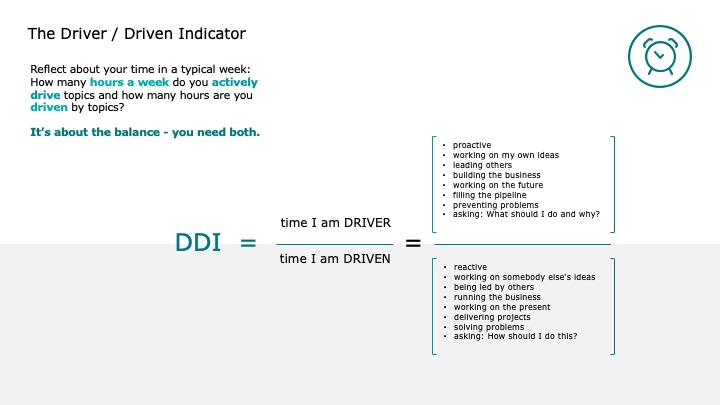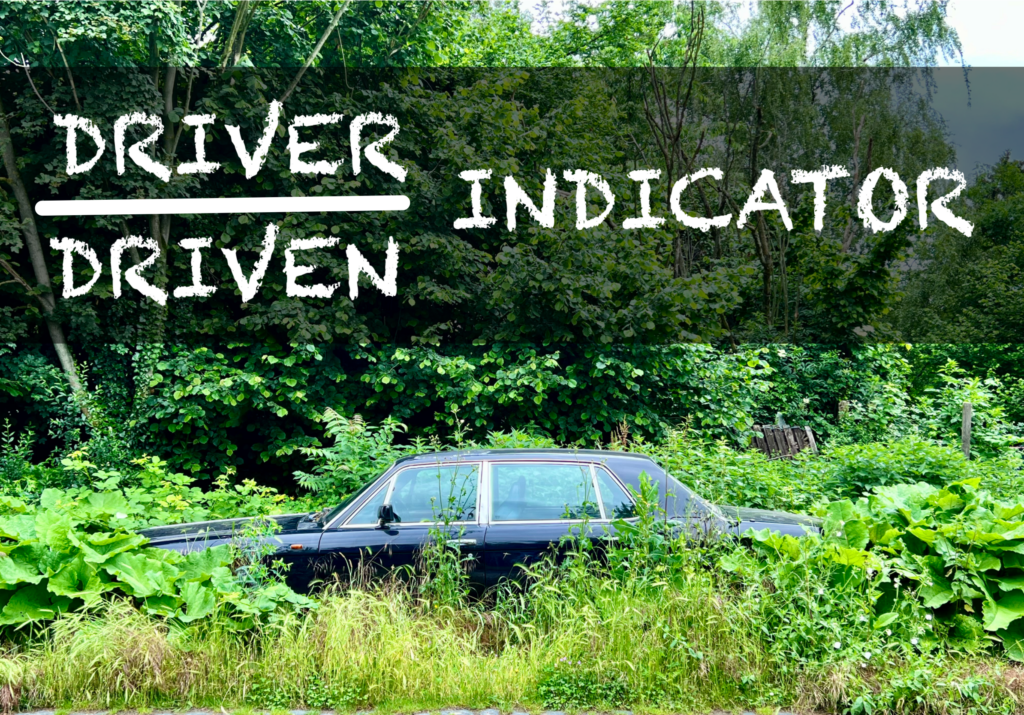The Driver / Driven Indicator.
A KPI to monitor whether personal change happens
There are two ways change happens. Suddenly or gradually.
Big shift – bold moves
Sometimes, change seems to happen in an instant – there is a sudden mindset shift that clearly tells you that “now is the time”, that inspires you for dramatic change and bold decisions. Finally quit your job, leave a relationship, move town, get healthy.
But What looks “sudden” from the outside, might have developed and been present for a long time, now breaking through the surface, whole and ready and very bossy.
The NewYou is very clear in telling you what to do, it takes the reigns and you execute, eager to leave OldYou behind, get it over with.
Gradual growth – smooth transition
Sometimes it is not so clear what happens. You notice a desire, an inkling, something inside that drives you, but it comes more subtle, non-aggressive. But you still like OldYou, you are not ready to leave it behind. And more importantly, there is no NewYou available yet who you could leave towards. You desire to have it, but you don’t – yet.
Still, you take a conscious decision to transition into NewYou, to start building a new identity from the safety of the one you currently inhabit. You either cannot or don’t want to do a sudden shift, be it because of current responsibilities you cannot quit, commitments you don’t want to break or fear of doing the change. Or it just takes a certain amount of time, by definition.
In this case, there is more active work involved. You might need to study for a higher education program that takes many months or years to complete. You might work through a number of steps to build the side hustle you have dreamt of for a long time. Or maybe you need to practice new skills to grow into new levels of competence that qualify you for the promotion you plan to apply for.
Such kind of change will not happen in an instant; it will take time to gradually shift into the new identity on the other side of the change.
And here is the risk.
How do you know you move forward?
In case of a bold and sudden shift you just know. It’s done the moment you realize. Then you need to clean up the mess this has caused, but you already know where you have arrived, providing clarity what to do. There is a very clear distinction between OldYou and NewYou.
In case of a longer-term, more subtle shift, there is a risk of slowing down, not getting traction, procrastination, being pulled back into the cozy home of OldYou. You don’t HAVE TO do this. Even if OldYou is not cozy – you are very busy in your current life –, at least you know who OldYou is and how they behave. This feels safe, comfy, competent.
So, you need to manage a gradual transition that will take time. You need to spend conscious efforts to start acting in the new identity, while either still clinging to the old voluntarily – or the old identity clinging to you and not letting you go so fast.
How do you know whether you move forward in this case?
Identity first, title second
I work with young Senior Consultants eager to being promoted to Manager level in a Consulting firm.
This step is a big one, for two major reasons.
It is attractive. The candidates are keen because of the benefits that come with it – status, money, new challenges, first leadership responsibilities, pride, sense of achievement. Both intrinsic and extrinsic motivation is nicely satisfied by gaining the title and accompanying new level of recognition.
It is demanding. Before the candidates get the title of a Manager, they are required to demonstrate the behavior of a Manager. They are expected to develop and drive a service offering that can be sold to clients – the dreaded “case” – which can only be done if they take first steps into entrepreneurial thinking – and acting. There is a big difference to their old selves, because they are expected to step up to the challenge and get behind the steering wheel of their own careers.
What does it take to become a manager?
It is not sufficient to become a better Senior Consultant. The old performance indicators are measuring the performance of the old identity. Even the best Senior Consultant will not be promoted to Manager if they do not grow up into the identity of a Manager first.
The Driver/Driven Indicator as a tool to monitor whether your identity is shifting
The expectations from the new level are clear from the HR role and competence framework, even though it is described rather abstract in generic terms. In a broad and diverse business environment like Consulting, each attempt to describe a role in very specific way will fail as each client and each project requires different nuances of support and hence different skills and behaviors of the people who serve them.
This leaves certain room for interpretation, leading to some confusion and sometimes frustration if candidates think they are ready and are still not promoted. “But I did everything on the list!” they claim. It is disappointing to learn that ticking off items on a list is not sufficient to get promoted to the next level.
“But, what do I need to do different?” they ask.
Don’t ask for things to do different, but for other things to do
This seems to be a necessary but insufficient question. The part that is missing is: “What else do I need to do?”
This is the question that inspired the “Driver / Driven Indicator”.
What exactly is the fundamental difference between the old identity of a Senior Consultant and the new identity of a Manager? How does it show in distinct behaviors?
I summarized and simplified this in a nutshell in the following definition:
Senior Consultant: You are driven. <==> Manager: You are the driver.
How to measure the gradual shift
Of course, the shift does not happen overnight. This cannot be a sudden switch. The candidates must become a Manager (NewYou) while still performing well as a Senior Consultant (OldYou) – fulfilling their client commitments in the role of Subject Matter Experts, Process Analysts, or whatnot. The need to start driving while still being driven.
Managing their own development, building their new identity while still being expected to act in the old role is part of the “growing up”, and it requires self-motivation, planning, and determination.
How can progress be measured? This is where the “Driver / Driven Indicator” (DDI) comes into play as a KPI to monitor the shift towards the new identity.
Of course this is not an official KPI that should be monitored by the firm – it could not, anyways, It is a suggestion, as it helps in the thinking process of what it takes to do this important and desired step in personal development – for the very personal use of the candidates themselves only.
Here is the formula:
DDI = time spent “driving” / time spent “being driven”
Time as a measurable unit and limiting factor: For a useful KPI, you need to measure stuff. As time is a finite resource, we can use it for measurement.
The behaviors of “driving”: Those are things a Manager would do, like being proactive, working on own ideas, leading others, building the business, working on the future, filling the pipeline, preventing problems, asking: what should I do and why.
The behaviors of “being driven”: Those are things a Senior Consultant would do, like being reactive, working on somebody else’s ideas, being led by others, running the business, working on the present, delivering projects, solving problems, asking: how should I do this.

Calculating the indicator is then simple: Look into your calendar, then add up the time spent with new behaviors and put it in relation to the time spent with old behaviors.
I have the number – what now?
So, what is a “good” number? And should there be a target number?
Well… it depends. Some considerations:
It is not a black-and-white situation – it all depends on the stage of the development of the respective person. If they are just starting out, expectations would be different from a person very close to promotion date.
The value is not in the absolute, but in the development over time. We are talking about a gradual shift, which will show in a gradual change of the KPI.
A constant “0” is problematic, though. If the DDI sits at zero, there is no shift happening yet.
A stagnant DDI indicates a stagnation in development. Growth taking place will show in an increase in the DDI.
Just increasing the total number of hours spent at work is not a sustainable strategy as it will lead to burn-out and indicates that the Senior Consultant identity is not yet ready to be shed.
Optimizing OldMe will make room for NewMe to happen, hence it is a good move. But it will not be sufficient as explained earlier. At some point, a letting-go of OldMe is required.
DIY – How to apply this idea to your own personal development
How can you use the idea of the Driver / Driven Indicator for your own personal development? Let’s take the formula apart:
[desired change] indicator = [units] of [new behavior] / [units] of [old behavior].
Some examples:
If you procrastinate building your side hustle because you feel the constant need to “learn more first”, you could create the Do / Learn Indicator = time spent building the business / time learning about how business should be done.
If you have a business and struggle growing it, you could calculate the Change / Run Indicator = time spent working on the business / time spent working in the business.
If you want to become a healthier person, calculate the Brokkoli / Candy Indicator = calories spent on vegetables / calories spent on junk food.
For investing in higher quality cloths, try the Cashmere / Polyacryl Indicator based on your monetary spend on clothing of either material.
To beat procrastination, put “doing” in relation to “planning”.
You get the idea.
The process is this:
Step 1: Understand the fundamental difference in behaviors of NewYou compared to OldYou.
Step 2: Attach a measurable unit to the defined behaviors.
Step 3: Put both in relation.
Step 4: Grow the number by shifting from the old to the new behavior.
OldYou deserves a place at the table
But why do we need a complicated formula? Why not just concentrate on NewYou, shift and be done?
If it were that easy, it wouldn´t be difficult… Why is change hard? Because it involves not only the gain of NewYou, which you desire and strive for, but it also involves the loss of OldYou.
As attractive as NewYou might be, there is value in OldYou. It has been your home for many years, it is the expression of the life you lived.
It is painful to let go – understandably so.
Just measuring NewYou would ignore OldYou which you cannot or do not want to dump. Putting both into the equation means to have both at the table, at eye level. It allows a gradual departure from OldYou without the painful cut.
Instead of fighting OldYou by trying to concentrate solely on NewYou, you can be the facilitator, moderating the transition from one to the other, helping in the negotiation between two valid identities you will have – for a while – at the same time.
Until, one day, OldYou will be quietly gone.
Get in Touch
What’s on your mind today? Share your thoughts and let’s connect.

